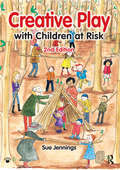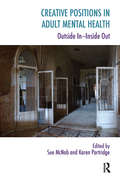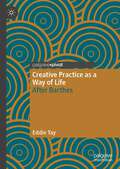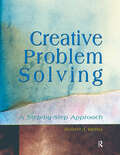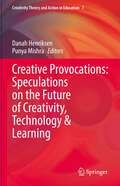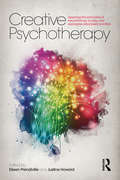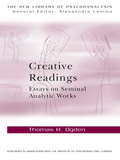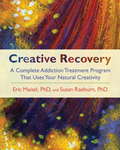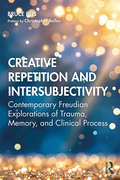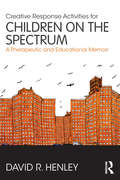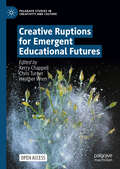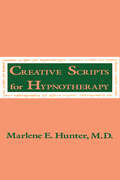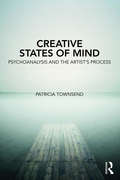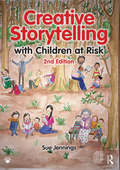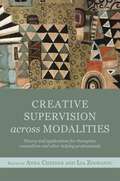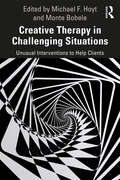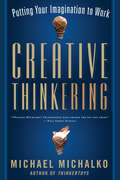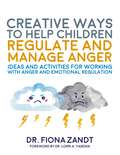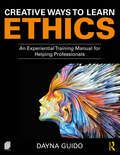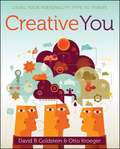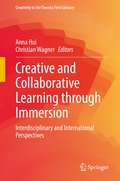- Table View
- List View
Creative Play with Children at Risk: At Risk And Creative Play With Children At Risk
by Sue JenningsThis second edition is fully updated with the latest good practice in play. Based on an understanding of 'Neuro-Dramatic-Play', the book shows that play is an essential part of children's healthy development and many children 'at risk' are those who are unable to play. It includes work with children with learning difficulties as well as those with developmental delay. The book includes current thinking on neuroscience and illustrates the importance of mindfulness in our work with children. Topics include: creating the safe space understanding and working with fear understanding and working with anger and rage new stories and worksheets cross cultural understanding of play dressing-up and enactment masks and puppets The book is written for teachers, parents and therapists, and all those who seek to enhance the lives of children.
Creative Positions in Adult Mental Health: Outside In-Inside Out (The Systemic Thinking and Practice Series)
by Sue McNab Karen PartridgeThis book presents cutting edge developments in Adult Mental Health through the presentation of creative and innovative applications of systemic theory to practice. The first section deconstructs the medical model with some of the current beliefs and practices shaping services whilst placing adult mental health in a wider social and political context. The second half of the book showcases good practice from the field. At either end of the volume "bookends" invite current clients and staff to write about their experiences with the aim of bringing a powerful personal context into the work. We intend to create a shift from third person objectivity to a first person experience as a political act which flows through the book.
Creative Practice as a Way of Life: After Barthes (Palgrave Studies in Creativity and Culture)
by Eddie TayThis book combines autoethnographic reflections, poetry, and photography with the aim to bridge the gap between creative practice and scholarly research. Drawing on an innovative combination of different forms of knowledge, creative writing and street photographs are presented as means to reflect on the development of knowledge and self-knowledge through a thought-provoking dialogue with Roland Barthes’ post-structuralist work. What does it mean to be a creative practitioner in a world traversed by values of capitalism and artificial intelligence? What does it mean to teach creative practices in such an environment?The urban landscape of Singapore, with the Jewel Changi mall, the Universal Studios, and Little India in the background, is the stage where the capitalist demands of modern city life grapple with the solitary act of writing poetry and taking photographs through the personal experience of the author. Capitalist realism and depression realism entwine with Barthes' notion of vita nova in a mesmerizing phantasmagoria that drags the reader to the bowels and secret pleasures of the creative process.
Creative Problem Solving: A Step-by-Step Approach
by Robert HarrisProvides step-by-step guidance on evaluating and implementing creative problem solving solutions. Ideal for all students who are pursuing careers as decision makers. Defines creative thinking and dispels misconceptions and negative attitudes that prevent students from taking creative approaches to their work.
Creative Provocations: Speculations on the Future of Creativity, Technology & Learning (Creativity Theory and Action in Education #7)
by Danah Henriksen Punya MishraThis book explores the complex, yet critical, relationship between technology and creativity, specifically in educational contexts. Creativity is important for success in today’s rapidly changing, radically contingent and hyperconnected world. This is even more relevant in the context of teaching and learning—where the psychological, sociological and cultural aspects of human learning confront the challenges of a rapidly changing, technologically saturated world. Written by some of the foremost thinkers and researchers in the area of creativity and/or technology, the chapters in this volume examine the impact of recent and future technologies on creativity, teaching and learning. Individually and collectively, they help us develop an understanding of this nexus of creativity and technology for education. They offer new perspectives on this rapidly evolving future—exploring issues, paradoxes, tensions, and points of interest for creativity and technology. They position these issues in ways that consider implications for thinking, learning, teaching, and education in general.
Creative Psychotherapy: Applying the principles of neurobiology to play and expressive arts-based practice
by Eileen Prendiville and Justine HowardCreative Psychotherapy brings together the expertise of leading authors and clinicians from around the world to synthesise what we understand about how the brain develops, the neurological impact of trauma and the development of play. The authors explain how to use this information to plan developmentally appropriate interventions and guide creative counselling across the lifespan. The book includes a theoretical rationale for various creative media associated with particular stages of neural development, and examines how creative approaches can be used with all client groups suffering from trauma. Using case studies and exemplar intervention plans, the book presents ways in which creative activities can be used sequentially to support healing and development in young children, adolescents and adults. Creative Psychotherapy will be of interest to mental health professionals working with children, adolescents and adults, including play and arts therapists, counsellors, family therapists, psychologists, social workers, psychiatrists and teachers. It will also be a valuable resource for clinically oriented postgraduate students, and therapists who work with victims of interpersonal trauma.
Creative Quest
by QuestloveNAMED A MOST ANTICIPATED BOOK OF 2018 BY Esquire • PopSugar • The Huffington Post • Buzzfeed • Publishers WeeklyA unique new guide to creativity from Questlove—inspirations, stories, and lessons on how to live your best creative lifeQuestlove—musician, bandleader, designer, producer, culinary entrepreneur, professor, and all-around cultural omnivore—shares his wisdom on the topics of inspiration and originality in a one-of-a-kind guide to living your best creative life. In Creative Quest, Questlove synthesizes all the creative philosophies, lessons, and stories he’s heard from the many creators and collaborators in his life, and reflects on his own experience, to advise readers and fans on how to consider creativity and where to find it. He addresses many topics—what it means to be creative, how to find a mentor and serve as an apprentice, the wisdom of maintaining a creative network, coping with critics and the foibles of success, and the specific pitfalls of contemporary culture—all in the service of guiding admirers who have followed his career and newcomers not yet acquainted with his story. Whether discussing his own life or channeling the lessons he’s learned from forefathers such as George Clinton, collaborators like D’Angelo, or like-minded artists including Ava DuVernay, David Byrne, Björk, and others, Questlove speaks with the candor and enthusiasm that fans have come to expect. Creative Quest is many things—above all, a wise and wide-ranging conversation around the eternal mystery of creativity.
Creative Readings: Essays On Seminal Analytic Works (The New Library of Psychoanalysis)
by Thomas H OgdenThomas H. Ogden is the winner of the 2004 International Journal of Psychoanalysis Award for the Most Important Paper of the year and the 2010 Haskell Norman Prize – an international award for "outstanding achievement as a psychoanalytic clinician, teacher and theoretician". Thomas Ogden is internationally recognized as one of the most creative analytic thinkers writing today. In this book he brings his original analytic ideas to life by means of his own method of closely reading major analytic works. He reads watershed papers in a way that does not simply cast new and discerning light on the works he is discussing, but introduces his own thinking regarding the ideas being discussed in the texts. Ogden offers expanded understandings of some of the most fundamental concepts constituting psychoanalytic theory and practice. He does so by finding in each of the articles he discusses much that the author knew, but did not know that he or she knew. An example of this is how Freud, in his conception of the unconscious workings of mourning and melancholia, was providing the foundation of a theory of unconscious internal object relations. Ogden goes on to provide further re-readings of classic material from the following key contributors to contemporary psychoanalysis: W. R. D. Fairbairn Donald Winnicott Wilfred Bion Hans Loewald Harold Searles. This book is not simply a book of readings, it is a book about reading, about how to read in a way that readers actively rewrite what they are reading, and in so doing makes the ideas truly their own. The concepts that Ogden develops in his readings provide a significant step in the reader’s expansion of his or her understanding of many of the ideas that lie at the cutting edge of contemporary psychoanalysis. It will be of particular interest to psychoanalysts and psychotherapists who use a psychodynamic approach, as well as professionals and academics with an interest in contemporary psychoanalysis.
Creative Recovery: A Complete Addiction Treatment Program That Uses Your Natural Creativity
by Eric Maisel Susan RaeburnFor writers, artists, musicians, and creators in every field, this book offers a complete addiction recovery program specifically designed for the creative person. Full of explanations and exercises, this book presents ways to use your own innate creative abilities in service of your recovery and at each stage of the recovery process. Topics include: the biological and developmental risks unique to creative people; the special personality traits that can inform the recovery process; ways to approach your recovery much like your art; and exercises that promote your creativity and art that aid the recovery process. This book gives a clear picture of the relationship between creativity and addiction and lays out a complete program so that you can live a fully creative and addiction-free life.To find out more about one of the authors, visit his website: www.ericmaisel.com.
Creative Repetition and Intersubjectivity: Contemporary Freudian Explorations of Trauma, Memory, and Clinical Process
by Bruce E. ReisCreative Repetition and Intersubjectivity looks at contemporary Freudian and post-Freudian theory through an intersubjective lens. Bruce Reis offers views on how psychoanalytic conceptions from the last century uniquely manifest in the consulting rooms of this century – how analytic technique has radically evolved through developing Freud’s original insights into dreaming, and hallucinosis; and how the presentation of today’s analysands calls for analyst’s use of themselves in unprecedented new ways. Taking up bedrock analytic concepts such as the death instinct, repetition, trauma and the place of speech and of silence, Reis brings a diversely inspired, twenty-first century analytic sensibility to his reworking of these concepts and illustrates them clinically in a process-oriented approach. Here the unconscious intersubjective relation takes on transformative power, resulting in the analyst’s experience of hybridized chimerical monsters, creative seizures, reveries and intuitions that inform clinical realities outside of verbal or conscious discourse -- where change occurs in analysis. Drawing on an unusually broad selection of major international influences, Creative Repetition and Intersubjectivity will be of great interest to psychoanalysts and psychoanalytic psychotherapists across the schools of thought.
Creative Response Activities for Children on the Spectrum: A Therapeutic and Educational Memoir
by David R. HenleyCreative Response Activities for Children on the Spectrum is a clear, comprehensive and intuitive guide that offers a wide selection of hands-on interventions to be used in any therapeutic or educational setting with children who are ‘on the spectrum’. From drawing and writing poetry to skiing and skateboarding, this book describes these and many other creative activities geared towards children with autistic features, attention deficits, hyperactivity, paediatric bipolar disorder and other related conditions. This new resource provides an innovative blend of theory and illustrative case examples designed to help therapists and educators assess children’s needs, formulate therapeutic and aesthetic interventions, and analyze creative outcomes.
Creative Ruptions for Emergent Educational Futures (Palgrave Studies in Creativity and Culture)
by Chris Turner Kerry Chappell Heather WrenThis open access book aims to show how creative ruptions – disturbances or commotions - can lead to the emergence of ethical, care-ful educational futures. Grounded in empirical and theoretical research undertaken from posthuman, decolonial, new materialist and feminist perspectives, this edited volume questions historical and current assumptions as to how education is structured and enacted, and provides examples and tools illustrating how to create and work with creative ruptions. Under the guidance of an experienced editorial team, the authors demonstrate how creative ruptions can respond to various wicked problems through the design and enactment of transformative pedagogies and accompanying research. Including consideration of how we can grow our emotional repertoires from anxiety to include hope and courage, the book explores how creativity might expand the horizons of personal, social and political possibility that take shape within – and ultimately determine – education and its futures.Offering theoretically driven and practically grounded transdisciplinary examples of alternative educational futures, this volume is an ideal reading for those interested in the intersecting fields of Possibilities Studies in Education, Creativity in Education, Educational Futures, Pedagogy, and related disciplines.
Creative Scripts For Hypnotherapy
by Marlene E. HunterFirst published in 1994, this book provides a selection of time-tested hypnotherapy scripts which aim to ease a variety of problems such as in the workplace, concerning pain relief, psychometric disorders, fears and phobias, self-discovery, memory retrieval, habit disorders, ego strengthening and sexual difficulties. The volume also intends to assist with such problems of childhood as enuresis, learning disabilities, fears, night terrors and asthma while also suggesting a variety of induction and self-hypnosis techniques. Hunter offers an insightful commentary alongside each script which exhibits state-of-the-art research as well as an expanded reference section and annotated bibliography. Its spacious format enables therapists to take notes as required and alter the script to meet the varying personal needs of their patients. Case histories and in-depth information as to how and when to use a particular script is also included.
Creative States of Mind: Psychoanalysis and the Artist’s Process
by Patricia TownsendWhat is it like to be an artist? Drawing on interviews with professional artists, this book takes the reader inside the creative process. The author, an artist and a psychotherapist, uses psychoanalytic theory to shed light on fundamental questions such as the origin of new ideas and the artist’s state of mind while working. Based on interviews with 33 professional artists, who reflect on their experiences of creating new works of art, as well as her own artistic practice, Patricia Townsend traces the trajectory of the creative process from the artist’s first inkling or ‘pre-sense’, through to the completion of a work, and its release to the public. Drawing on psychoanalytic theory, particularly the work of Donald Winnicott, Marion Milner and Christopher Bollas, the book presents the artist’s process as a series of interconnected and overlapping stages, in which there is a movement between the artist’s inner world, the outer world of shared ‘reality’, and the spaces in-between. Creative States of Mind: Psychoanalysis and the Artist’s Process fills an important gap in the psychoanalytic theory of art by offering an account of the full trajectory of the artist’s process based on the evidence of artists themselves. It will be useful to artists who want to understand more about their own processes, to psychoanalysts and psychotherapists in their clinical work, and to anyone who studies the creative process.
Creative Storytelling with Children at Risk: At Risk And Creative Play With Children At Risk
by Sue JenningsThis second edition is fully updated and addresses ways in which we can apply stories and storytelling with children who are troubled. Stories can empower children to take action and ask for help, including help with changes and life-plans. Stories provide a secure structure with endings and closure. The book develops the following topics: Stories for assessment Stories for understanding emotions Stories for exploring the senses Stories for managing loss Stories for ritual and drama There are new and revised stories, in particular addressing trauma and abuse. This book is written for all those people with the welfare of children as their priority.
Creative Supervision Across Modalities: Theory and applications for therapists, counsellors and other helping professionals
by Jane Leach Hannah Sherbersky Fiona Hoo Lia Zografou Amanda Strevett-Smith Anna Chesner Denise Mchugh Eleni Ioannidou Céline Butté Cath WakemanCreative methods can bring depth and new perspectives to the supervision process. This book proposes that a firm understanding of supervision theory is the vital foundation to utilising the power of creativity in reflection and learning, and demonstrates that these creative approaches are applicable across disciplines, providing useful reflective tools across and beyond the arts therapies. Part One of the book provides a theoretical approach to supervision, with a presentation and discussion of the philosophy, theory and place of creative technique. Part Two demonstrates the fluency of creative approaches to supervision with examples of application within different fields, including dramatherapy, psychodrama, family therapy, art therapy, psychoanalytic psychotherapy, dance and movement therapy and church ministry, provided by experienced practitioners from within those fields. Based in the practice and philosophy of the Creative Approaches to Supervision Diploma course run by the editors and taught at the London Centre for Psychodrama Group and Individual Psychotherapy, this book is a comprehensive resource for anyone with an interest in supervision across the caring and educational disciplines.
Creative Themes for Groupwork and Personal Development
by Susan Pinn-Atkinson Jenny WoolloffBased around thirty themes, this practical resource provides flexible and adaptable ideas for groupwork sessions. The themes in this book: can be adapted and developed to match the exact needs and interests of the participants; aim to generate and inspire group facilitators to think broadly and creatively, and to feel confident in using the culture and history of their geographical area to enrich the work they do with participants; enable participants to explore, develop and reflect upon their hidden, unidentified or unacknowledged strengths, transferable skills and knowledge; have a variety of alternative or additional ideas, and many are accompanied by worksheets; and include colour, television, soaps, touch, mirrors, maps, weather and many more.
Creative Therapies for Complex Trauma: Helping Children and Families in Foster Care, Kinship Care or Adoption
by Janet Smith Alan Burnell Joy Hasler Anthea Hendry Elizabeth Taylor Buck Franca Brenninkmeyer Hannah Guy Jay Vaughan Marion Allen Martin Gibson Molly Holland Renee Potegieter Marks Sarah Ayache Sue TopalianA burgeoning evidence base supports that arts, play and other creative therapies have potential to help children in foster care, kinship care or adoptive families to recover from complex trauma. Written by contributors working at the cutting edge of delivering effective therapeutic interventions, this innovative book describes models for working with children in foster care, kinship care or adoption. Covering how to assess needs and contextual considerations for working with children and families, this book presents a range of creative therapeutic approaches spanning art psychotherapy, music therapy and dance therapy. It emphasizes the necessity of working with caregivers and other significant adults, as well as the child, to facilitate recovery. The theoretical foundations of attachment, developmental psychology and neurobiology are embedded in each chapter showing how they underpin each of the recommended creative therapies. This book will be suitable for professionals directly employing creative approaches in their practice, such as arts therapists and play therapists, as well as those working with children who are interested in creative alternate approaches, such as psychologists, counsellors, therapists and social workers.
Creative Therapies with Traumatised Children
by Anne BannisterAs a probation officer and social worker, Anne Bannister has successfully used creative therapies with abused children for 25 years. Combining her practical experience and recent doctoral research she reflects on how and why these therapies actually work in the healing process. She shows how in 'the space between' children and their therapists, the child and adult can each use their creative skills to aid developmental processes, reverse negative brain patterns and affect positive behavioural changes to heal the damage caused by severe abuse in childhood. The author presents a practical model called the Regenerative Approach to use when assessing and working therapeutically with traumatised children. Her research has implications for those working in the field of children's development and learning, and provides an important new approach for social workers, creative therapists and all those who work with traumatised children.
Creative Therapy in Challenging Situations: Unusual Interventions to Help Clients
by Monte Bobele Michael HoytCreative Therapy in Challenging Situations introduces readers to the innovative approaches that therapists sometimes take when standardized, paint-by-numbers routines don’t work. Each chapter presents the story of one or more difficult psychotherapy situations followed by the therapists’ descriptions of what they did and why, as well as the outcome that resulted. The authors and their stories span a wide variety of theoretical approaches and contexts, showing how clinicians can improvise beyond everyday scenarios and techniques. This collection of provocative, instructive vignettes from well-known practitioners often generates “You said what?!” reactions while encouraging readers to think creatively in the moment in order to reach healthy, innovative outcomes from the trickiest and most unexpected therapeutic scenarios.
Creative Thinkering: Putting Your Imagination to Work
by Michael MichalkoWhy isn’t everyone creative? Why doesn’t education foster more ingenuity? Why is expertise often the enemy of innovation? Bestselling creativity expert Michael Michalko shows that in every ?eld of endeavor — from business and science to government, the arts, and even day-to-day life — natural creativity is limited by the prejudices of logic and the structures of accepted categories and concepts. Through step-by-step exercises, illustrated strategies, and inspiring real-world examples, he shows readers how to liberate their thinking and literally expand their imaginations by learning to synthesize dissimilar subjects, think paradoxically, and enlist the help of the subconscious mind. He also reveals the attitudes and approaches that diverse geniuses share — and anyone can emulate. Fascinating and fun, Michalko’s strategies facilitate the kind of lightbulb-moment thinking that changes lives — for the better.
Creative Ways to Help Children Regulate and Manage Anger: Ideas and Activities for Working with Anger and Emotional Regulation
by Fiona ZandtSupport children to better understand and manage their anger with this practical guide of therapeutic activities. From exploring a child's first steps in therapy to helping parents and carers with their responses, this book provides practical advice for working with children aged 4-12 and families navigating issues of anger and emotional regulation.The book includes over fifty playful, practical, and purposeful activities to use in therapy. Grounded in theory and research around anger in children, the activities include clear therapeutic rationales for practitioners, considerations for older and younger children, suggestions for the inclusion of parents and carers, and adaptations for online practice. This is the ultimate tool for therapists looking to develop their clinical practice with creative ways to help children manage their anger.
Creative Ways to Learn Ethics: An Experiential Training Manual for Helping Professionals
by Dayna GuidoCreative Ways to Learn Ethics is an accessible, easy-to-read guide that compiles a variety of ethics trainings to help professionals stimulate their minds, relieve stress, and increase engagement and memory retention. The book uses a range of experiential and thought-provoking approaches, including contemplative exercises, expressive arts, games, and media. Each chapter contains objectives, detailed procedures, adaptations for different audiences, and handouts. Trainers, educators, clinicians, and other mental health professionals can use these exercises in various settings and modify them to meet the needs of their clients.
Creative You: Using Your Personality Type to Thrive
by Otto Kroeger David B. GoldsteinNo matter what your passion is—business, technology, science, or plumbing—this practical guide will enable you to unleash your innate creative skills based on your unique personality type and succeed in everything you do.Whether you can admit it to yourself or not, you are creative. In today’s complex world, creativity is the key to finding and living your passion. Whatever that passion is—cooking, technology, writing, or even plumbing—Creative You reveals your own personal style of creativity to help you build an environment of innovation at work and home. Discover your creative personality type with a simple quiz and detailed descriptions of the sixteen personality types. Plus, tools and techniques show you how to apply creativity to your everyday life. Drop excuses like I’m too old to start being creative and creativity is only for artists. Confidently use creativity to live your passion by using your natural style. Whether you are starting from scratch or enhancing an already developed skill, discover the creative you that you’ve been searching for.
Creative and Collaborative Learning through Immersion: Interdisciplinary and International Perspectives (Creativity in the Twenty First Century)
by Christian Wagner Anna HuiThis book includes instructional design and practice of how immersive technology is integrated in discipline-based and interdisciplinary curriculum design. It focuses on pedagogical models and learning outcomes of immersive learning experiences and demonstrates how immersive learning can be applied in industries. This book brings scholars, researchers and educators together around an international and interdisciplinary consolidation and reflection on learning through immersion. The originality lies in how advanced technology and contemporary pedagogical models can integrate to enhance student engagement and learning effectiveness in higher education.
